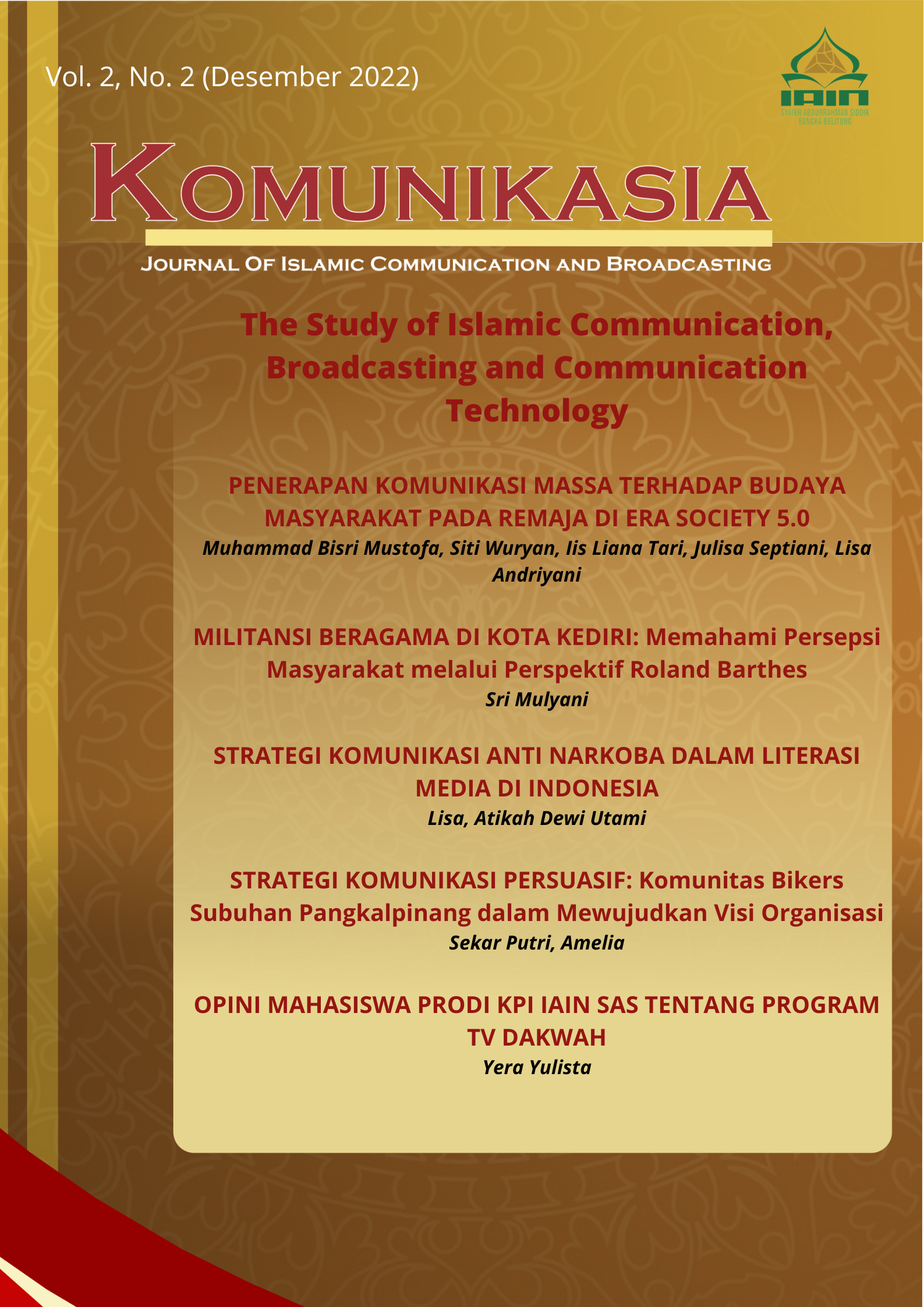MILITANSI BERAGAMA DI KOTA KEDIRI
Memahami Persepsi Masyarakat melalui Perspektif Roland Barthes
Abstract
Religion that is global and dramatic in people's lives creates pluralism. Religious militancy in the public sphere is required to be mutually transparent and inclusive. Multiculturalism has given rise to religious movements with various applied sciences. The emergence of religious groups in the community in an area sometimes creates a variant of perception. These dynamics follow the rhythm of the frictions of the reality of life. This striking symbol and different characteristics have created a flurry of perception from groups who are not as Kufu. In the city of Kediri, there is a place of worship that is thought to be the center of a different and exclusive group. Positive and negative stigma emerges from several public perceptions of this phenomenon. The mixed fanfare was motivated by several factors. For that we need understanding from each individual or group. Because every individual has a variety of differences in ideological views. This can be influenced by religious understanding, educational background, and experience of each person. Thus, extensive knowledge is needed to address and assess in order to avoid misunderstandings and social inequality. Some of the areas studied by the researcher are about the symbols and various essential motives hidden behind the presence of militant groups. Therefore, the researcher dissects this sensitive phenomenon using perception theory from the perspective of Roland Barthes' semiotica.
Downloads
References
Afifuddin, Beni Ahmad Saebani. Metodologi Penelitian Kualitatif. Bandung: Pustaka Setia, 2009.
Alwasillah A. Chaedar, Pokoknya Kualitatif Dasar Dasar Merancang dan Melakukan Penelitian Kualitatif, (Jakarta: Pustaka Jaya, 2011)173
Ardian Donny Gahral. Teori Militansi Esai-esai Politik Raikal. Depok: Koekoesan. 2011.
Arifin, Imron. Penelitian Kualitatif dalam Ilmu-Ilmu Sosial dan Keagamaan. (Malang: Kalmia Husada Press, 1996) ,49.
Cangara, Hafied. Pengantar Ilmu Komunikasi. Jakarta: PT. Raja Grafindo Persada, 2011.
Effendy, Onong Uchjana. Ilmu Komunikasi, Teori dan Praktek. Bandung: PT. Remaja Kosda Karya, 1990.
Onong Uchjana Effendy. Ilmu Komunikasi Teori dan Praktek, Bandung: PT Remaja Rosdakarya, 1998.
Effendy, Onong Uchjana. Ilmu Komunikasi Teori dan Praktek. Bandung: PT Remaja Rosdakarya, 2015.
Ghony, Djunaidi, dan Fauzan Almanshur. Metodologi Penelitian Kualitatif. Yogyakarta: Ar-Ruzz Media, 2014.
Handayani, Diah. Proses Embodiment Perempuan-Perempuan Ter-Ekslusi, Media Kita 2013.
Moelong, Lexy J. Metode Penelitian Kualitatif . Bandung: PT. Remaja Rodakarya, 1993.
Morissan. Manajemen Public Relations Strategi Menjadi Humas Profesional. Jakarta: Kencana Prenada Media Group, 2008.
Mulyana, Dedy. Ilmu Komunikasi: Suatu Pengantar. Bandung: Remaja Rosdakarya, 2014.
Noorhaidi, Laskar Jihad Militansi dan Pencarian Identitas di Indonesia Pasca-Orde Baru, Jakarta: Pustaka LP3ES Indonesia, 2008.
Pawito. Penelitian Komunikasi Kualitatif. Yogyakarta: PT. LkiS Pelangi Aksara, 2007.
Pujileksono, Sugeng. Metodologi Penelitian Komunikasi Kualitatif. Malang: Intrans Publishing, 2015.
Sirry, Mun’im. Membendung Militansi Agama Iman dan Politik dalam Masyarakat Modren
Thari. Menggugat Otentitas Jilbab dan Hijab “Konsep Berpakaian ala Syahrur”, Jakarta: Erlangga, 2003
Website :
www.bsn.go.id diakses tanggal 02 Maret 2018
http://www.psb-psma.org. di akses tanggal 17 Agustus 2018
http://www.google.co.id/amp/s/silabus.org/komunikasi-efektif/
Copyright Notice
Komunikasia: Journal of Islamic Broadcasting and Communication is under the Creative Commons Attribution 4.0 International (CC-BY 4.0) License, according to which:
1) Authors retain copyright and grant the journal the right to first publication, with the work simultaneously licensed under the Creative Commons Attribution (CC-BY 4.0) that allows the sharing of articles published with the acknowledgment of authorship and the initial publication in this journal.
2) The authors are authorized to make additional contracts separately for distribution of the version of the work published in this journal (for example, publication in an institutional repository or as a chapter of the book), as long as there is recognition of authorship and initial publication in this journal.
3) Authors are authorized and encouraged to publish and distribute their work online (for example, in institutional repositories or on their personal pages) at any time before or during the editorial process, as it increases the impact and reference of the published work.



















